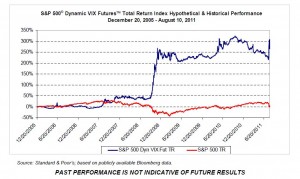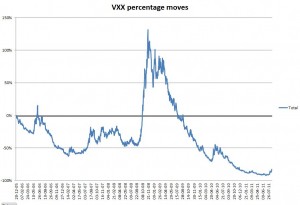Almost everyone that invests would love to have a cost-effective way to insure against market declines. Securities that allow you to go long on volatility are attractive because they tend to go up when the market goes down, but none of them, when sized to really protect an investment are affordable in a “set and forget” sort of way.
The first generation volatility ETNs like Barclay’s VXX and VXZ (now replaced with VXXB and VXZB), enabled investors to bet on volatility without using futures or options, but VXX suffers greatly from contango in non-fearful times. It has dropped from a split-adjusted $26500 a share at its inception in early 2009 to $14 in May 2017—a loss of 99.95%. Gathering accolades like: “VXX may be the worst investment vehicle ever created”, Barclays was wise to not sit on its laurels even with VXX holding over $1 billion in assets.
Another first generation fund, UBS’s XVIX, (no longer in existence) added the innovation of shorting a percentage of short term futures while being long medium-term futures, but it had a totally uninspiring existence from its creation in February 2011. Its fixed 50% short, 100% long mix of short and medium futures has failed to do anything. Another follow-on fund, CitiGroup’s CVOL (also no longer in existence), added a dynamic component—a variable short position in the S&P 500, adjusted monthly. However, this adjustment, intended to make CVOL act more like the VIX index, did nothing to protect itself from contango. It also suffers greatly during the non-panic times.
Barclays uses both of these techniques but adapts them to reducing the contango induced costs of being long volatility. These backtested results, taken from the XVZ prospectus, looked very impressive. Unfortunately, contango in the medium term volatility VIX futures that XVZ holds increased considerably starting in 2010 which led to large losses (-30% April 2012 to April 2013) in the fund. From 2014 on XVZ has held its value better, but there is still erosion of value that won’t completely stop until the next big correction or bear market boosts XVZ’s value back up.

.
.
.
.
.
.
.
.
The big jump and lack of decay after the 2008/2009 crash is astonishing. The scale of the chart is so vast that it could be misleading, but compared to the equivalent VXX chart, XVZ looks very, very good. Update: I have backtested XVZ myself now. See the results here.

.
.
.
.
.
.
.
.
..
..
.

Vance, the xiv is consisted of the first 2 contracts and not the medium term contracts from what I understand, Still, the mean reversion is not new (and that is why we have backwardation in the first place) but still a few weeks ago we saw vix going down from 48 to less than 35 and xiv barely moved and now the performance is much better.
I think we are missing something here….
Hi Jones,
You are correct, I should have said 1st and 2nd month futures. In terms of missing something, I’d have to hear more. The VIX and the index that XIV tracks are not that closely coupled, so it doesn’t surprise me when they don’t track well on a day to day basis.
— Vance
Guys, have you noticed xiv is behaving better in the last 2 trading days? for example today vix is up almost 11% and xiv is only down 2%, it should have been must worse watching weeks before and considering backwardation today is about 3 points.
Any explanation for this behavior? and Andrew why not taking a long vxx position as long as backwardation seems to stay around for a bit longer than expected?
Hi Jones,
I think what we are seeing is mean reversion. Even if the futures stay in backwardation, if both short and medium term volatility futures drop then XIV will benefit. VIX does not stay at these high levels for long, and it you think about it, backwardation is the futures market predicting that volatility will go down from current levels.
— Vance
Hi,
Got a basic question. For these ETP’s, what is the likelihood of being called early?
I searched thru the XVZ prospectus and I did not find a termination level of price
like other iPath ETN’s at $10. What if in some extreme situation one’s position gets
redeemed early at a loss? Could anybody put some specific numbers on what to
watch for in XVZ to be prepared for such risks? Thanks.
Hi,
It appears that XVZ does not have an automatic termination event, unlike VZZB, IVO, or XXV. Barclay clearly documents the termination in http://www.ipathetn.com/VZZB-overview.jsp but it is nowhere to be found in XVZ’s overview: http://www.ipathetn.com/XVZ-overview.jsp
Until we know more about XVZ, it will be a bit of an unknown. A very fast market panic, e.g., a terrorist attack might be the worst case for it–although it certainly wouldn’t be alone, and even in that case it might do ok because of its long medium term volatility position.
— Vance
Jones, as always, it’s nice if there were some backtesting to a concept like 1:1 XVZ to XIV. For instance, during good times, XVZ will be short short term volatility and so will XIV, so what if some terrible thing happened then that didn’t affect medium term volatility? So since XVZ is a changing amalgam of long and medium term volatility and the structure of volatility spikes is so different each time, I would like to see some hypothetical backtesting of such a mix…
Jones, like I said I am looking at the XVZ methodology of changing long/short position on VXX (thus short/long on XIV) given ratio of VIX to VXV. If VIX is higher, VIX futures prices are likely in backwardation and you get bled to death; if VIX is lower than VXV, VIX futures are likely back to contango and XIV looks like it accumulates value day to day. Seems to me if they come up with a new investment vehicle (XVZ) based on the VIX to VXV ratio, they must have run it through a lot of backtesting and decided this ratio was worth acting upon. Anyway,
your idea of XVZ plus XIV counteracts the fact XVZ is mostly a safety position and allows you to make money in good times and break even in stressful times. Might work… but XVZ is not very liquid right now (bid/ask spread was within 20 cents yesterday and then ballooned to over 2 bucks all of a sudden). Also, how much XIV would you want to own to balance XVZ. I suppose a 1:1 ratio would work… because in the most stressful times XVZ is 50% long short term volatility and 50% long medium term volatility and XIV is 100% short short term volatility, so almost balanced. So your idea makes sense… hopefully XVZ will get more popular, and so it’ll be easier to trade.
And still waiting to hear guys whay do you think about holding xiv and xvz at the same time as a position for normal times?
Hi Jones,
I’m with Andrew on this one. Until I can get some backtesting done I don’t have a feel how for how a XVZ / XIV mix would do. In fact I don’t have much of a feel for XVZ by itself. I don’t understand why it didn’t fade after the 2008/2009 crash for example. I plan to do a backtest of XVZ, but I want a couple of weeks of real data to validate my simulation.
— Vance
Vance, like I said before it seems xiv is losing 3-4 % a day!!! beacuse of decay.
At that pace another month or two can take xiv to 2-3 or some other number that will kill the investment. I have no problem to enter at 4 for example after 100% up move because it would still be much better price than right now and contango behind me.
Are we assuming that the back testing will prove to be more reliable than xvix? Or does the idea make more intuitive sense?
Hi Baruch,
XVIX made assumptions about the ratio between short term and medium term futures. XVZ makes assumptions about the short term VIX vs 3 month VXV volatility estimates, and how well they correlate with short/medium volatility futures. I like the dynamic allocation that XVZ makes–it seems like a better approach.
— Vance
Hey Vance and Jones,
It’s true that you can lose going in and out..but the backwardation stacks the odds against you..if you get in when it’s in contango it can flip back and if it does you’ll sell again..as in, if you hold now you definitely have odds stacked against you. if you sell and buy back when odds are in your favor it’s 50/50 of it flipping back (at most).
Jones, I agree with you having been beaten down hold XIV for too long. I sold out of XIV this morning, and this is a new experience for me because XIV always seemed to bounce back quickly before. Anyway, I’m thinking of using the VIX / VXV ratio as a criterion for when to get back into XIV. So maybe I will miss some of the upmove, but the way volatility has settled at these high levels for so long, it’s like it’s the ‘new normal’. So in that case, hanging around and just taking backwardation losses seems pointless.
Andrew & Vance, another question about xiv: don’t you think it would be wiser to cut losses right now with such big backwardation that doesnt seem to go anywhere and enter again when vix is back in contango? It doesnt really matter the price of xiv at that point just the fact you want to long it only when things go back to normal.
Can you please explain to me what is the logic behing holding long xiv right now?
Hi Jones,
My problem with getting out, and then back in is timing. It is never easy to jump back, because in the short term you are just as likely to lose money as make it. Probably I’m just being stubborn.
— Vance
Vance, what’s interesting about xvz is the switching mechanism based on the vix / vxv ratio. This seems to beg the question of what would be the performance of a portfolio that switched between xiv and cash depending on whether vix was less than or greater than vxv…
For now it is not liquid enough to trade, but it looks good.
Maybe when vix goes down a position of long xiv and long xvz at the same time might be a winner. During normal times enjoy the contango of xiv while xvz doens’t seem to lose so much during those times and when vix spikes our long xvz position would give us hedging to the losing xiv position. what do you think?
Hey Vance,
Can you give more details on this? I read Andrew’s post which was helpful but not detailed enough for a beginner like me.
Thanks
Vance, thanks for telling us about this interesting new product! Looking at the prospectus, it looks like it shifts from -30%/70% short/medium volatility to 50%/50% short/medium when VIX transitions from being low to being high. The switch is based on the ratio of vix compared to a 3-month volatility index vxv evaluated on the previous business day. If vix was relatively low on the previous day, we would get the -30%/70% mix; if it was relatively high we would get the 50%/50% mix; for intermediate values we get something in between the two mixes. Well sort of. There is a daily rebalancing limit of 12.5% per index business day. So, XVZ could be short short term volatility for several days during a major shock. But I guess they tried different formulations and figured this one played out the best against the available historical data on VIX spikes…